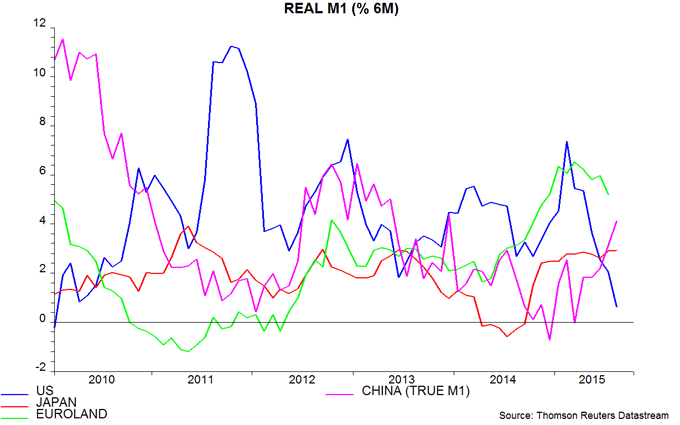Entries from September 13, 2015 - September 19, 2015
Is the consensus wrong about US / Chinese economic prospects?
Economists expect stronger US growth next year but a further slowdown in China. The average forecast for US GDP growth in 2016 is 2.7%, up from 2.3% in 2015, according to Consensus Economics. Chinese GDP expansion, meanwhile, is projected to fall from 6.9% to 6.7%. Given a widespread belief that GDP data are manipulated, the consensus probably expects a larger decline in actual Chinese growth.
Narrow money trends, however, are giving an opposite message for economic prospects. Six-month growth of US real (i.e. consumer price-deflated) M1 fell to 0.6%, or 1.3% at an annualised rate, in August, the lowest since January 2010. Chinese real “true” M1* growth, by contrast, rose to 4.1%, or 8.3% annualised, a 20-month high – see chart.
Narrow money signals have provided valuable insights in both countries in recent years. US six-month real M1 growth fell in summer 2014 ahead of an economic “soft patch” in early 2015. It rebounded strongly around end-2014, predicting faster economic expansion over the summer / autumn: GDP rose by 3.7% annualised in the second quarter. Chinese real true M1, meanwhile, contracted during the second half of 2014, forewarning of recent economic weakness.
Narrow money is a leading indicator because the demand to hold it is influenced importantly by spending intentions. The US M1 slowdown suggests that households and firms have turned more cautious and are scaling back their plans, possibly temporarily, ahead of expected Fed policy tightening. The Chinese pick-up, by contrast, is evidence that monetary and fiscal policy easing is gaining traction by lifting confidence and spending intentions.
Chinese M1 strength contradicts claims that domestic liquidity would contract as a result of foreign exchange intervention to support the currency (“quantitative tightening”). Such claims amount to treating Chinese monetary arrangements as a pure currency board, ignoring the panoply of tools available to the authorities to offset intervention effects on the monetary base and money holdings of households and firms.
If the message of current narrow money trends is correct, US GDP growth will, once again, fall short of the consensus forecast in 2016, suggesting limited pressure for Fed rate hikes. A rebound in China, meanwhile, should support global economic expansion. Such a combination could imply a favourable backdrop for markets. Additional US M1 weakness, however, or a relapse in China, would be concerning.
*True M1 = official M1 plus household demand deposits. Official M1 = cash in circulation plus demand deposits of corporations and government organisations. Annual true M1 growth rose to 8.9% in August from a low of 2.0% in March.

UK job openings suggesting further pay pick-up
UK pay growth is picking up strongly, consistent with the historical relationship with the job openings or vacancy rate*, a measure of labour market tightness. This relationship suggests a continued upswing through mid-2016, at least.
Average weekly regular earnings (i.e. excluding bonuses) rose by 3.2% in the year to July, the largest annual increase since 2008. Private sector growth was 3.7% versus only 1.1% in the public sector – the recent gap is the largest on record in data extending back to 2001.
The latest Bank of England argument for delaying raising interest rates is that the pay pick-up is being accompanied by faster productivity expansion, so unit labour cost growth remains too low. This may not be true for much longer but, in any case, stronger productivity growth is a double-edged sword for policy, since it also suggests faster trend GDP expansion and a higher “equilibrium” level of rates.
The current earnings pick-up is consistent with the historical relationship with the job openings rate. As noted in a post in September 2014, “the openings rate bottomed in 2009 but embarked on a sustained rise only in the second quarter of 2012. Based on the average nine-quarter lag following the three increases over 1970-90, this suggests an upswing in earnings growth starting in the third quarter of 2014.” Regular earnings growth has risen steadily from a low of 0.7% in the second quarter of 2014 – see chart**.
The increase in pay growth is more impressive against a backdrop of falling / low consumer price inflation, which would be expected to subdue wage demands.
The job openings rate rose further in the fourth and first quarters, surpassing its 2008 high, though has since fallen slightly. If the first quarter peak is confirmed, the minimum six-quarter lead over 1970-90 would suggest a continued uptrend in earnings growth through the third quarter of 2016, at least.
*Vacancies as a percentage of employee jobs plus vacancies.
**Quarterly data except for the last data points, which refer to July for earnings and the three months to August for the openings rate.


